Intro To Version Control
Download as ODP, PDF0 likes498 views
Provides an absolute beginner\'s guide to how version control works, why you should switch and how to get started. Note that this presentation was for Design 4 Drupal, so it is angled towards Drupal themers.
1 of 20
Downloaded 14 times


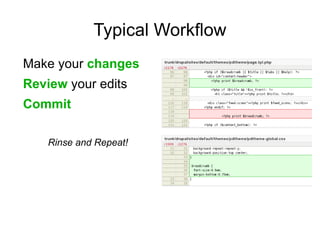

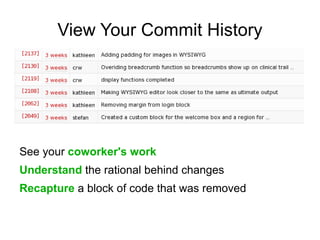
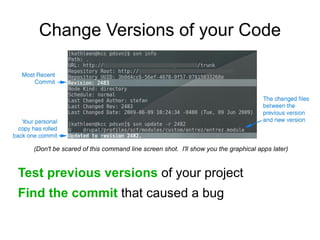
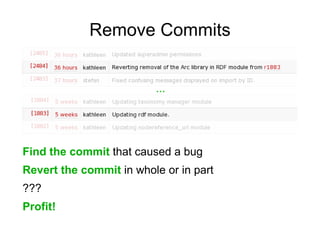

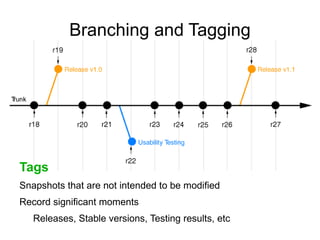




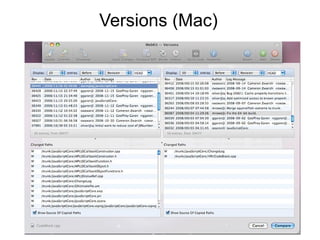






Recommended
Composer



ComposerZaib Un Nisa
Ã˝
Composer is a dependency manager for PHP projects that allows developers to declare and install dependencies and their versions. It guarantees consistency across team members and environments by locking dependency versions in a composer.lock file. To use Composer, a project's dependencies are defined in a composer.json file. Running "composer install" will install all dependencies into the vendor folder from the versions specified in composer.lock. Composer can be used with frameworks like Drupal and WordPress to manage their core files and dependencies.Using svn



Using svnShiva Somvanshi
Ã˝
This document provides an introduction to Subversion (SVN), a version control system. It describes key SVN concepts like the repository, trunk, branches, and tags. The trunk contains the main codebase, branches are for experimental work, and tags save stable versions. SVN allows developers to track changes, rollback mistakes, experiment safely without breaking the main code, and collaborate effectively. It works by having a central repository that all developers update and commit their code to. This ensures everyone works from the latest version and changes can be merged automatically. The document outlines best practices like using branches for new features, tagging stable builds, committing with detailed messages, and updating frequently.SVN Basics



SVN BasicsShiva Somvanshi
Ã˝
This document introduces SVN concepts and best practices. It discusses the benefits of version control such as tracking changes, rolling back mistakes, and collaborating on code. It explains how the SVN workflow involves developers checking out code from a central repository, making changes locally, and committing changes back. The document outlines the trunk, branch, and tag file structure and describes branches as experimental code and tags as saved versions. It provides examples of common SVN commands like add, commit, update, and viewing changes. Finally, it offers best practices such as small commits, updating before working, and writing descriptive commit messages.Svn tutorial



Svn tutorialkalyansiri
Ã˝
This document provides an overview of the key operations in the Subversion (SVN) version control system life cycle. It describes creating a repository, checking out a working copy, updating changes from the repository, performing edits and other changes locally, reviewing pending changes, fixing mistakes by reverting changes, and resolving conflicts when merging changes. The main operations covered are checkout, update, commit, status, diff, revert, and merge.Manen Ant SVN



Manen Ant SVNSriskandarajah Suhothayan
Ã˝
This document provides an overview of Apache build tools including Subversion (SVN), Apache Ant, and Apache Maven. It discusses how SVN allows multiple developers to work on the same project files, the purpose of version control, and some SVN terminology. It then explains how Ant is used to automate software build processes using XML scripts and targets. Finally, it outlines the conventions and lifecycle of Maven projects including dependencies, plugins, repositories, and releasing projects.Composer talk by Maxim Romanovsky



Composer talk by Maxim Romanovskyphp-user-group-minsk
Ã˝
Use Composer locally and commit the lock file to the repository. No stable version of Composer exists yet. Developers and CI servers should use the same Composer version. Optimize the autoloader and understand how install, update, and require work. Only use update to upgrade dependencies and check that the lock file is not accidentally committed during code reviews.Jenkins advance topic



Jenkins advance topicGourav Varma
Ã˝
Jenkins Pipeline uses a master-slave architecture to execute builds across multiple nodes. The Jenkinsfile defines the continuous delivery pipeline using Declarative or Scripted syntax. It contains stages for building, testing, and deploying with steps to define tasks. Maven is used to manage dependencies and build processes. It defines projects using a POM file containing identifiers, dependencies, repositories, plugins, and build configuration.Jenkins introduction



Jenkins introductionGourav Varma
Ã˝
This document provides an introduction and overview of Jenkins, an open-source automation tool for continuous integration. It discusses that Jenkins is written in Java and uses plugins to enable continuous integration through automation of various DevOps stages. Some key advantages are that it is open-source, easy to install, has many plugins, and is free. The document also covers what continuous integration is, why it is needed to detect problems early, and the different stages of adopting a continuous integration approach.Continuous Integration



Continuous IntegrationJoseph Wang
Ã˝
The document discusses continuous integration (CI), including its benefits, when to implement it, who should use it, and how to set it up. CI involves developers integrating code daily and having an automated build test for quick error detection. Benefits include better quality, faster development, and cheaper defect fixing. The document recommends setting up a code repository, automated build script, and CI server to start. It also provides examples of best practices and demo tools like Hudson.Source Code management System



Source Code management SystemKarthikeyan Annamalai
Ã˝
A source code management system (SCM) provides coordination and services for software development teams. It provides file management and version control to prevent developers from overwriting each other's work. SCMs also allow developers to work concurrently through branches, merge changes, track requested changes and bugs, and manage releases.Continuous Integration with Bamboo for Salesforce



Continuous Integration with Bamboo for SalesforceKlea Kolaric
Ã˝
This document discusses using Bamboo for continuous integration in Salesforce development. Bamboo is a continuous integration server from Atlassian that supports builds in many languages using tools like Ant and Maven. It can deploy Salesforce metadata and code using the Force.com Migration Tool. A Bamboo build defines a deployment process through plans, jobs, tasks and variables to deploy changes from a repository on a scheduled or triggered basis, while tracking deployments, permissions, and notifications. Considerations for using Bamboo include project size and type, limitations on deployable components, and occasional dependency issues.Subversion Overview



Subversion Overviewpolarion
Ã˝
Subversion is a leading open source version control system that provides features for:
- Backing up data and configuration management through atomic commits to a centralized repository.
- Distributed development via easy branching and tagging of project files and revisions.
- Integrations for Windows, Linux, Unix, and web-based access through modules like Apache.Android Talks #05 - Android labs notifier



Android Talks #05 - Android labs notifierInfinum
Ã˝
When developers release a new app version, they often want to notify existing users that an update is available. We have the same problem when deploying new test versions apps developed for our clients. Our solution for the problem is something called Lab notifier. Branching Strategies For Git and Subversion



Branching Strategies For Git and SubversionElian, I.
Ã˝
The document discusses branching strategies for Subversion and Git source control systems. For Subversion, the trunk is used for development and branches are used for releases and bug fixes. Changes are merged back into the trunk. For Git, the develop branch is used for development, the master branch is the golden image with no direct check-ins, and release and bugfix branches are used for releases which are deployed from those branches. Tags are used to mark specific versions in both systems.SVN Tool Information : Best Practices



SVN Tool Information : Best PracticesMaidul Islam
Ã˝
What is svn?
how svn works ?
diagram of SVN ?
Merging with SVN ?
Conflict With SVN ?
Checkout and Checkin ,update ,branch , tags ?
what is version control "?
SVN file directory ?
Directories locked in Tags ?Build 2017 - B8096 - Ten things you didn’t know about Visual Studio 2017 for ...



Build 2017 - B8096 - Ten things you didn’t know about Visual Studio 2017 for ...Windows Developer
Ã˝
With the new Windows 10 Creators Update, .NET Standard, and changes to NuGet, there is a lot going on in the world of .NET Windows development. We made this session to keep you up to date with the new tools for UWP development. Improvements have been made all around - from installation and getting started, all the way to tools that help you test and publish your apps. Along the way we show you tips and tricks to accelerate your Windows app development. SVN Usage & Best Practices



SVN Usage & Best PracticesAshraf Fouad
Ã˝
The document provides an overview of using Subversion (SVN) for source code control, including how to set up SVN clients and servers, basic and advanced SVN commands, best practices for usage, and how to install the VisualSVN server software. SVN allows developers to concurrently edit and manage different versions of code through features like revision tracking, merging, branching and locking files during edits. The document recommends using SVN for both individual developers and development teams to avoid issues with shared network drives and provides instructions for getting started with clients like TortoiseSVN and servers like VisualSVN.MVVM Light for UWP



MVVM Light for UWPRobert Iagar
Ã˝
A small about how to implement the Model View ViewModel in the Universal Windows Platform using MVVM LightVersion Control and Continuous Integration



Version Control and Continuous IntegrationGeff Henderson Chang
Ã˝
This is Greg Montaño's slides on "Version Control and Continuous Integration", which was presented at the Cebu StackOverflow Meetup on 26 May 2012.Subversion Best Practices



Subversion Best PracticesMatt Wood
Ã˝
The document discusses best practices for using branches and tags in Subversion (SVN) source control management. It recommends creating branches for independent changes, releases, and experiments, while keeping the trunk stable. Releases should be tagged in the correct branch. Branches can be merged back to trunk after changes. SVN hooks and continuous integration tools can automate integration tasks.Production ready word press



Production ready word pressEdmund Turbin
Ã˝
This document discusses deploying code using version control and continuous integration. It recommends developing code locally, using distributed version control like Git, and deploying to a testing environment before production. Continuous integration helps multiple developers share code by automatically verifying each code push. The workflow involves local development, a central version control repository, continuous integration pipelines to build and test code, and deploying builds to servers. Initial setup involves cloning repositories, installing applications, and configuring environments. The script provided automates deploying code from Codeship to a Git repository, running Composer to install dependencies, committing changes, and running post-deployment tests with Assertible.Create an architecture for web test automation



Create an architecture for web test automationElias Nogueira
Ã˝
Presentation at Oracle Code 2018 in San Francisco showing how to create a test architecture for web automationProduction Ready WordPress - WC Utrecht 2017



Production Ready WordPress - WC Utrecht 2017Edmund Turbin
Ã˝
This document discusses deploying code using version control and continuous integration. It recommends developing code locally, using distributed version control like Git, and deploying to a testing environment before production. The solution involves setting up continuous integration where multiple developers can share code and have automated builds and testing on each push. A workflow is proposed where code is developed locally, stored in a central version control repository, built through continuous integration pipelines, and deployed to servers. Tools like Composer, NPM, Gulp and Assertible are demonstrated in an example deployment script for automated testing and deployment.SVN Best Practices



SVN Best Practicesabackstrom
Ã˝
This document provides best practices for using Subversion (SVN), a version control system. It discusses SVN commands like checkout, add, delete, copy, move, commit, update, and status. It emphasizes checking in changes regularly in distinct commits with clear messages, updating working directories before editing or committing, and using SVN commands instead of shell commands to maintain history. The document also recommends regularly checking the status of working directories and outlines a typical SVN repository structure with trunk for production code and branches and tags for development and snapshots.Production Ready WordPress #WPLDN



Production Ready WordPress #WPLDNEdmund Turbin
Ã˝
This document discusses using version control and continuous integration to deploy code. It recommends developing code locally, using distributed version control like Git, and deploying to a testing environment before production. The continuous integration workflow involves multiple developers sharing code through a central version control repository. Each code push is verified by automated builds to avoid integration issues and catch problems early. The document provides an example deployment script for Codeship that checks out code, installs dependencies, builds assets, commits changes, and pushes to the production remote. It also discusses testing deployments using Assertible and lessons learned around caching packages, installing dependencies, and using forceful Git pushes for deployment.Introduction to Integration Testing With Cypress



Introduction to Integration Testing With CypressErez Cohen
Ã˝
A quick overview over Cypress, a front end testing library, going over the motivation to incorporate it for integration tests and some best practices of how to use it.Version Control With Subversion



Version Control With SubversionSamnang Chhun
Ã˝
This document provides an overview of version control and Subversion (SVN). It defines version control as the management of changes to documents and files. It discusses why version control is needed, such as for backup, synchronization, tracking changes and owners. It then describes the basic concepts and terminology of SVN like repositories, working copies, revisions, checkouts, checkins and updates. The document also demonstrates the basic SVN workflow and architecture. It concludes with best practices for using SVN.An introduction to Version Control Systems



An introduction to Version Control SystemsJon Warbrick
Ã˝
Version control systems allow users to track changes to documents and code over time, maintain revision histories, and collaborate on projects. They provide features like check-outs that allow editing working copies, commits to save changes to repositories, diffs to view differences between versions, and merging of changes from multiple branches. Version control is well-suited for software source code management and collaborative work, but not as effective for tasks like bug tracking or large media files.More Related Content
What's hot (20)
Continuous Integration



Continuous IntegrationJoseph Wang
Ã˝
The document discusses continuous integration (CI), including its benefits, when to implement it, who should use it, and how to set it up. CI involves developers integrating code daily and having an automated build test for quick error detection. Benefits include better quality, faster development, and cheaper defect fixing. The document recommends setting up a code repository, automated build script, and CI server to start. It also provides examples of best practices and demo tools like Hudson.Source Code management System



Source Code management SystemKarthikeyan Annamalai
Ã˝
A source code management system (SCM) provides coordination and services for software development teams. It provides file management and version control to prevent developers from overwriting each other's work. SCMs also allow developers to work concurrently through branches, merge changes, track requested changes and bugs, and manage releases.Continuous Integration with Bamboo for Salesforce



Continuous Integration with Bamboo for SalesforceKlea Kolaric
Ã˝
This document discusses using Bamboo for continuous integration in Salesforce development. Bamboo is a continuous integration server from Atlassian that supports builds in many languages using tools like Ant and Maven. It can deploy Salesforce metadata and code using the Force.com Migration Tool. A Bamboo build defines a deployment process through plans, jobs, tasks and variables to deploy changes from a repository on a scheduled or triggered basis, while tracking deployments, permissions, and notifications. Considerations for using Bamboo include project size and type, limitations on deployable components, and occasional dependency issues.Subversion Overview



Subversion Overviewpolarion
Ã˝
Subversion is a leading open source version control system that provides features for:
- Backing up data and configuration management through atomic commits to a centralized repository.
- Distributed development via easy branching and tagging of project files and revisions.
- Integrations for Windows, Linux, Unix, and web-based access through modules like Apache.Android Talks #05 - Android labs notifier



Android Talks #05 - Android labs notifierInfinum
Ã˝
When developers release a new app version, they often want to notify existing users that an update is available. We have the same problem when deploying new test versions apps developed for our clients. Our solution for the problem is something called Lab notifier. Branching Strategies For Git and Subversion



Branching Strategies For Git and SubversionElian, I.
Ã˝
The document discusses branching strategies for Subversion and Git source control systems. For Subversion, the trunk is used for development and branches are used for releases and bug fixes. Changes are merged back into the trunk. For Git, the develop branch is used for development, the master branch is the golden image with no direct check-ins, and release and bugfix branches are used for releases which are deployed from those branches. Tags are used to mark specific versions in both systems.SVN Tool Information : Best Practices



SVN Tool Information : Best PracticesMaidul Islam
Ã˝
What is svn?
how svn works ?
diagram of SVN ?
Merging with SVN ?
Conflict With SVN ?
Checkout and Checkin ,update ,branch , tags ?
what is version control "?
SVN file directory ?
Directories locked in Tags ?Build 2017 - B8096 - Ten things you didn’t know about Visual Studio 2017 for ...



Build 2017 - B8096 - Ten things you didn’t know about Visual Studio 2017 for ...Windows Developer
Ã˝
With the new Windows 10 Creators Update, .NET Standard, and changes to NuGet, there is a lot going on in the world of .NET Windows development. We made this session to keep you up to date with the new tools for UWP development. Improvements have been made all around - from installation and getting started, all the way to tools that help you test and publish your apps. Along the way we show you tips and tricks to accelerate your Windows app development. SVN Usage & Best Practices



SVN Usage & Best PracticesAshraf Fouad
Ã˝
The document provides an overview of using Subversion (SVN) for source code control, including how to set up SVN clients and servers, basic and advanced SVN commands, best practices for usage, and how to install the VisualSVN server software. SVN allows developers to concurrently edit and manage different versions of code through features like revision tracking, merging, branching and locking files during edits. The document recommends using SVN for both individual developers and development teams to avoid issues with shared network drives and provides instructions for getting started with clients like TortoiseSVN and servers like VisualSVN.MVVM Light for UWP



MVVM Light for UWPRobert Iagar
Ã˝
A small about how to implement the Model View ViewModel in the Universal Windows Platform using MVVM LightVersion Control and Continuous Integration



Version Control and Continuous IntegrationGeff Henderson Chang
Ã˝
This is Greg Montaño's slides on "Version Control and Continuous Integration", which was presented at the Cebu StackOverflow Meetup on 26 May 2012.Subversion Best Practices



Subversion Best PracticesMatt Wood
Ã˝
The document discusses best practices for using branches and tags in Subversion (SVN) source control management. It recommends creating branches for independent changes, releases, and experiments, while keeping the trunk stable. Releases should be tagged in the correct branch. Branches can be merged back to trunk after changes. SVN hooks and continuous integration tools can automate integration tasks.Production ready word press



Production ready word pressEdmund Turbin
Ã˝
This document discusses deploying code using version control and continuous integration. It recommends developing code locally, using distributed version control like Git, and deploying to a testing environment before production. Continuous integration helps multiple developers share code by automatically verifying each code push. The workflow involves local development, a central version control repository, continuous integration pipelines to build and test code, and deploying builds to servers. Initial setup involves cloning repositories, installing applications, and configuring environments. The script provided automates deploying code from Codeship to a Git repository, running Composer to install dependencies, committing changes, and running post-deployment tests with Assertible.Create an architecture for web test automation



Create an architecture for web test automationElias Nogueira
Ã˝
Presentation at Oracle Code 2018 in San Francisco showing how to create a test architecture for web automationProduction Ready WordPress - WC Utrecht 2017



Production Ready WordPress - WC Utrecht 2017Edmund Turbin
Ã˝
This document discusses deploying code using version control and continuous integration. It recommends developing code locally, using distributed version control like Git, and deploying to a testing environment before production. The solution involves setting up continuous integration where multiple developers can share code and have automated builds and testing on each push. A workflow is proposed where code is developed locally, stored in a central version control repository, built through continuous integration pipelines, and deployed to servers. Tools like Composer, NPM, Gulp and Assertible are demonstrated in an example deployment script for automated testing and deployment.SVN Best Practices



SVN Best Practicesabackstrom
Ã˝
This document provides best practices for using Subversion (SVN), a version control system. It discusses SVN commands like checkout, add, delete, copy, move, commit, update, and status. It emphasizes checking in changes regularly in distinct commits with clear messages, updating working directories before editing or committing, and using SVN commands instead of shell commands to maintain history. The document also recommends regularly checking the status of working directories and outlines a typical SVN repository structure with trunk for production code and branches and tags for development and snapshots.Production Ready WordPress #WPLDN



Production Ready WordPress #WPLDNEdmund Turbin
Ã˝
This document discusses using version control and continuous integration to deploy code. It recommends developing code locally, using distributed version control like Git, and deploying to a testing environment before production. The continuous integration workflow involves multiple developers sharing code through a central version control repository. Each code push is verified by automated builds to avoid integration issues and catch problems early. The document provides an example deployment script for Codeship that checks out code, installs dependencies, builds assets, commits changes, and pushes to the production remote. It also discusses testing deployments using Assertible and lessons learned around caching packages, installing dependencies, and using forceful Git pushes for deployment.Introduction to Integration Testing With Cypress



Introduction to Integration Testing With CypressErez Cohen
Ã˝
A quick overview over Cypress, a front end testing library, going over the motivation to incorporate it for integration tests and some best practices of how to use it.Version Control With Subversion



Version Control With SubversionSamnang Chhun
Ã˝
This document provides an overview of version control and Subversion (SVN). It defines version control as the management of changes to documents and files. It discusses why version control is needed, such as for backup, synchronization, tracking changes and owners. It then describes the basic concepts and terminology of SVN like repositories, working copies, revisions, checkouts, checkins and updates. The document also demonstrates the basic SVN workflow and architecture. It concludes with best practices for using SVN.Build 2017 - B8096 - Ten things you didn’t know about Visual Studio 2017 for ...



Build 2017 - B8096 - Ten things you didn’t know about Visual Studio 2017 for ...Windows Developer
Ã˝
Viewers also liked (11)
An introduction to Version Control Systems



An introduction to Version Control SystemsJon Warbrick
Ã˝
Version control systems allow users to track changes to documents and code over time, maintain revision histories, and collaborate on projects. They provide features like check-outs that allow editing working copies, commits to save changes to repositories, diffs to view differences between versions, and merging of changes from multiple branches. Version control is well-suited for software source code management and collaborative work, but not as effective for tasks like bug tracking or large media files.Version Control Systems - ArabNet Beirut 2014 - Dani Arnaout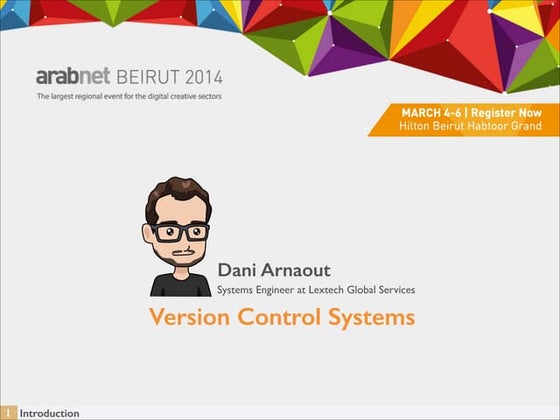



Version Control Systems - ArabNet Beirut 2014 - Dani ArnaoutDani Arnaout
Ã˝
This is the presentation that was given at ArabNet Beirut 2014. It cover some basic & intermediate info about Version Control Systems in a simple & special way.
It includes lots of images & just few text, so you won't be able to fully understand what's going on unless you watched the talk.
Will add a link to the talk once it becomes available.Distributed Version Control (DVCS) With Mercurial



Distributed Version Control (DVCS) With MercurialTed Naleid
Ã˝
Distributed version control presentation with a focus on Mercurial and it's usage as well as a live-coding section01 - Introduction to Version Control



01 - Introduction to Version ControlSergii Shmarkatiuk
Ã˝
This document provides an introduction to version control. It discusses what version control is, the history and evolution of version control systems, different types of version control systems classified by their repository model and concurrency model, and practical considerations for starting to use version control. Key topics covered include centralized and distributed version control, lock-modify-unlock and merge models, and domain vocabulary for common version control tasks and workflows.The everyday developer's guide to version control with Git



The everyday developer's guide to version control with GitE Carter
Ã˝
Git is a distributed version control system that allows developers to track changes in source code. It provides tools to commit changes locally, branch code for parallel development, and collaborate remotely by pushing and pulling changes from a shared repository. Common Git commands include init to create a repository, add and commit to save changes locally, checkout to switch branches, pull to retrieve remote changes, and push to upload local changes. Git helps developers work efficiently by enabling features like branching, undoing mistakes, and viewing the revision history.A brief introduction to version control systems



A brief introduction to version control systemsTim Staley
Ã˝
This is a lunchtime talk I gave to the Southampton astronomy department. The aim was to make them aware of version control systems and when they might need to use them.Intro to Git, GitHub, and BitBucket



Intro to Git, GitHub, and BitBucketLegal Services National Technology Assistance Project (LSNTAP)
Ã˝
With these slides we introduce the concept of source control and teach the core features to using Git, GitHub and BitBucket. You can find the accompanying video here. https://youtu.be/lZpNrCgGvuIWhat is version control software and why do you need it?



What is version control software and why do you need it?Leonid Mamchenkov
Ã˝
Version control software (VCS) manages changes to files such as documents, images, and code. It allows users to undo changes, try ideas, collaborate, and troubleshoot. VCS originated from engineering blueprints and software development in the early UNIX days. It works by storing revisions in a repository with branches and tags. Git is the most commonly used VCS as it is free, distributed, fast, and the standard for open source projects. Users can get started by installing Git, configuring user information, initializing repositories for projects, and committing file changes with descriptive messages.Version Control with SVN



Version Control with SVNPHPBelgium
Ã˝
This document provides an overview of version control using Subversion (SVN). It discusses key SVN concepts like the trunk, branches, and tags. It explains how SVN allows for collaboration between developers and management of code revisions. The document also summarizes SVN features like authentication, revision management, tagging for releases, and advanced topics like hooks and externals.Introduction to Version Control



Introduction to Version ControlJeremy Coates
Ã˝
Version control is a method for centrally storing files and keeping a record of changes made by developers. It allows tracking who made what changes and when. This allows developers to back up their work, track different versions of files, merge changes from multiple developers, and recover old versions if needed. Centralized version control systems like Subversion store all files in a central repository that developers check files out from and check changes back into. Subversion allows viewing changes between versions, rolling back changes, and recovering old project versions with a single version number across all files.Similar to Intro To Version Control (20)
Jbossworld Presentation



Jbossworld PresentationDan Hinojosa
Ã˝
The document provides an overview of agile development using JBoss Seam. It discusses various agile methodologies and technologies that will be presented, including TestNG, Groovy, Hudson, Subversion, Cobertura, DBUnit, and Selenium. It provides descriptions and examples of using these technologies for unit testing, integration testing, and acceptance testing in an agile project.Presentation 1 open source tools in continuous integration environment v1.0



Presentation 1 open source tools in continuous integration environment v1.0Jasmine Conseil
Ã˝
The document discusses open source tools that can be used in a continuous integration environment. It provides an overview of build tools like Ant and Maven, continuous integration servers, and how tools like Hudson and Archiva can help manage builds, artifacts, and the development process in an agile workflow.Azure DevOps for JavaScript Developers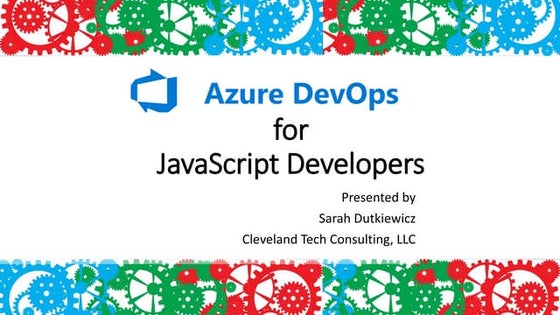



Azure DevOps for JavaScript DevelopersSarah Dutkiewicz
Ã˝
The document provides an overview of Azure DevOps and why JavaScript developers should use it. It discusses features like source control, boards for tracking work items, pipelines for continuous integration and delivery, and testing. It also includes a demo of setting up a sample Create React App project in Azure DevOps, including configuring a pipeline to build and deploy the app to an Azure App Service. Resources for learning more about Azure DevOps, using it with JavaScript projects, and understanding Git are also provided.Building Scalable Development Environments



Building Scalable Development EnvironmentsShahar Evron
Ã˝
The document provides guidelines for building scalable development environments in 3 main areas:
1. Establish standard programming styles and coding practices to reduce bugs and improve readability. This includes using source control, peer review, and coding standards.
2. Implement a multi-tier environment with separate development, staging, and production servers to allow for testing at each stage.
3. Employ practices like unit testing, functional testing, and benchmarking to ensure quality and performance as the system grows.Version Management in Maven



Version Management in MavenGeert Pante
Ã˝
This document discusses best practices for software version management in Maven. It covers what software versioning is, how Maven can help through plugins like the Maven release plugin, and tips for organizing Maven modules and versions. Key recommendations include using the Maven release plugin to manage releases, determining what scope to version (individual modules, applications or systems), and using Maven plugins like dependency:tree to analyze dependencies and versions:use-next-snapshots to update versions.Feature Based Web Development with Bazaar



Feature Based Web Development with Bazaaryogomozilla
Ã˝
We take a look at feature based development using Bazaar. We cover version control evolution, what a feature is, how to develop features rathr than file changes and finally providing those features for provisioning of your web app!Application versioning



Application versioningTed Steinmann
Ã˝
This document discusses basics of branching, tagging and packaging for product release management with SVN. It covers why SVN is used, environmental considerations, branching strategies including the unstable trunk strategy, tagging, versioning, packaging, and merging in Subversion. Branching allows independent lines of development while maintaining a shared history. Tagging creates snapshots for versions. Packaging gathers artifacts like source code and database scripts into repeatable releases. Merging integrates changes between branches.Subversion in 2010 and Beyond



Subversion in 2010 and Beyondguest1243d91
Ã˝
The document summarizes several topics discussed at a Subversion conference. It introduces upcoming features in Subversion 1.7 including improved support for HTTPv2, a next generation working copy system, and new capabilities for modifying repository history. It also describes projects to implement the Subversion API in Java and provide commercial Subversion services.Subversion in 2010 and Beyond



Subversion in 2010 and BeyondWANdisco Plc
Ã˝
Learn what's coming from the developers building it.
Highlights include:
HTTPv2.0
This update of the current WebDAV HTTP protocol will boost performance while preserving the benefits of providing web access to Subversion.
SVNJ
A rich server-side JAVA API that leverages Subversion's established code base. SVNJ will enable the Subversion community to reach out to millions of JAVA developers to create the same rich functionality and extensibility on the server that's available on the client.
Obliterate
A new feature that cleanly removes obsolete files and other data from Subversion repositories. Obliterate will include comprehensive audit and recovery capabilities to guarantee that history is always available.
Working Copy
New features include centralized metadata storage and improved extensibility. These enhancements will lay the groundwork for offline commits and other capabilities normally associated with distributed version control systems.Whats New In 2010 (Msdn & Visual Studio)



Whats New In 2010 (Msdn & Visual Studio)Steve Lange
Ã˝
This document provides an overview and summary of new features in Visual Studio 2010 and Team Foundation Server 2010. It begins with introducing the product lineup and changes to MSDN subscriptions. Major sections then summarize new capabilities in project management, reporting, version control, architecture/modeling tools, development aids like profiling and testing tools like lab management and coded UI tests. The document aims to outline the key updates and highlights for developers across the application lifecycle with Visual Studio 2010 and TFS.Practical SVN for PHP Developers



Practical SVN for PHP DevelopersLorna Mitchell
Ã˝
This document provides an overview of using Subversion (SVN) for version control, including:
- Installing and setting up an SVN repository with trunk, branches and tags structures
- Common SVN commands like checkout, commit, status and log
- Best practices for committing changes in discrete units and avoiding conflicts
- Advanced topics like branching/tagging strategies, merging, authentication/authorization, and using hooks for tasks like running tests and notificationsDevOps Tutorial For Beginners | DevOps Tutorial | DevOps Tools | DevOps Train...



DevOps Tutorial For Beginners | DevOps Tutorial | DevOps Tools | DevOps Train...Simplilearn
Ã˝
This presentation about DevOps will help you understand what is DevOps, how is DevOps different from traditional IT, benefits of DevOps, the lifecycle of DevOps and tools used in DevOps processes. DevOps is one of the most trending IT jobs. It is a collaboration between development and operation teams which enables continuous delivery of applications and services to our end users. However, if you want to become a DevOps engineer, you must have knowledge of various DevOps tools (like Git, Maven, Selenium, Jenkins, Docker, Ansible, Nagios etc.) to achieve automation at each stage which helps in gaining Continuous Development, Continuous Integration, Continuous Testing and Continuous Monitoring in order to deliver a quality product to the client at a very fast pace. Now, let us get started and understand DevOps and does the various DevOps tools work.
Below are the topics explained in this DevOps presentation:
1. What is DevOps?
2. Benefits of DevOps
3. Lifecycle of DevOps
4. Tools in DevOps
Why learn DevOps?
Simplilearn’s DevOps training course is designed to help you become a DevOps practitioner and apply the latest in DevOps methodology to automate your software development lifecycle right out of the class. You will master configuration management; continuous integration deployment, delivery, and monitoring using DevOps tools such as Git, Docker, Jenkins, Puppet, and Nagios in a practical, hands-on and interactive approach. The DevOps training course focuses heavily on the use of Docker containers, a technology that is revolutionizing the way apps are deployed in the cloud today and is a critical skillset to master in the cloud age.
After completing the DevOps training course you will achieve hands-on expertise in various aspects of the DevOps delivery model. The practical learning outcomes of this Devops training course are:
An understanding of DevOps and the modern DevOps toolsets
The ability to automate all aspects of a modern code delivery and deployment pipeline using:
1. Source code management tools
2. Build tools
3. Test automation tools
4. Containerization through Docker
5. Configuration management tools
6. Monitoring tools
Who should take this course?
DevOps career opportunities are thriving worldwide. DevOps was featured as one of the 11 best jobs in America for 2017, according to CBS News, and data from Payscale.com shows that DevOps Managers earn as much as $122,234 per year, with DevOps engineers making as much as $151,461. DevOps jobs are the third-highest tech role ranked by employer demand on Indeed.com but have the second-highest talent deficit.
1. This DevOps training course will be of benefit the following professional roles:
2. Software Developers
3. Technical Project Managers
4. Architects
5. Operations Support
6. Deployment engineers
7. IT managers
8. Development managers
Learn more at https://www.simplilearn.com/cloud-computing/devops-practitioner-certification-trainingMaven.pptx



Maven.pptxpiyushkumar613397
Ã˝
Maven is a build automation tool that provides a standard directory structure and conventions to simplify software development. It uses plugins and repositories to manage dependencies and build processes. Maven defines common phases like validate, compile, test, package, and deploy that allow configuring a project's build lifecycle. It is well-suited for running unit and integration tests as part of the normal build. SonarQube is an open-source tool that performs static code analysis to generate reports on code quality metrics like bugs, vulnerabilities, duplications, and code smells to help maintain quality over a project's lifespan.Source code management



Source code managementWidoyo PH
Ã˝
This document provides an overview of source code management and version control systems. It discusses traditional methods of saving code versions, introduces centralized and distributed version control systems, and covers common terms and processes used in version control like branching, committing, tagging, and logging. It also provides a high-level overview of using Git for version control tasks like initializing a repository, adding/committing code, branching, merging, and viewing logs or diffs of changes.Part 4 - Managing your svn repository using jas forge



Part 4 - Managing your svn repository using jas forgeJasmine Conseil
Ã˝
This document discusses version control systems and Subversion (SVN) in particular. It provides an overview of SVN, including its features for managing file changes, branches and tags. It also discusses how SVN is integrated with JasForge to provide full source code management capabilities including access rights and authentication.De-centralised Version Control with Bazaar



De-centralised Version Control with BazaarStuart Colville
Ã˝
This was the presentation I gave on Bazaar version control at Yahoo!'s internal front-end engineering summitPart 2 improving your software development v1.0



Part 2 improving your software development v1.0Jasmine Conseil
Ã˝
The document discusses improving software development processes through continuous integration using agile tools. It describes how build tools can automate various parts of the software development process, including compiling, testing, packaging, and deploying code. Maven is presented as a common build tool that supports a well-defined development lifecycle. Continuous integration principles are explained, emphasizing how integrating code changes frequently and running automated builds can reduce integration issues. Hudson is introduced as an open-source continuous integration server that supports automation and provides feedback. The JasForge project aims to manage agile tools like Hudson in an integrated platform to control the software development process.Subversion



Subversionwiradikusuma
Ã˝
Version control systems like Subversion allow multiple developers to work on the same codebase simultaneously. It keeps track of all changes made over time and supports releasing multiple versions concurrently. Subversion stores every version of files, allows branching for parallel development, and uses merging to integrate changes between branches. It uses a centralized model where a repository stores all file versions and branching/merging occurs through copying directories.Azure DevOps for Developers



Azure DevOps for DevelopersSarah Dutkiewicz
Ã˝
This document provides an overview of Azure DevOps and how it can benefit developers. It discusses key features such as source control, work item tracking, continuous integration and delivery pipelines, and how SQL Server Data Tools can be used. The presenter has over 20 years of experience in technology and is a Microsoft MVP. They provide a demonstration of using Azure DevOps and SSDT for a database project. Resources for learning more are also included.Embracing Distributed Version Control



Embracing Distributed Version ControlNowell Strite
Ã˝
This document discusses the benefits of distributed version control systems (DVCS) like Git over centralized version control systems (CVCS) like SVN. It argues that DVCS tools make collaboration and branching much easier and more flexible. Various workflow models for DVCS are presented, including integrating feature branches and using different roles like integration managers. The document provides references for learning more about Git and distributed version control.Intro To Version Control
- 1. An Introduction to Using Version Control with Drupal Kathleen Murtagh Design 4 Drupal -- June 14, 2009
- 2. Why use Version Control? Constant backup of your project
- 3. Full history of your project's development
- 4. Reuse code that was previously removed
- 5. Remove changes that caused bugs
- 6. Enable collaborative development
- 7. Easier deployment to production
- 8. Typical Workflow Make your changes
- 9. Review your edits
- 10. Commit Rinse and Repeat!
- 11. Commits are Patches Multiple developers can work on the same file
- 12. View Your Commit History See your coworker's work
- 13. Understand the rational behind changes
- 14. Recapture a block of code that was removed
- 15. Change Versions of your Code (Don't be scared of this command line screen shot. I'll show you the graphical apps later) Test previous versions of your project
- 16. Find the commit that caused a bug
- 17. Remove Commits Find the commit that caused a bug
- 18. Revert the commit in whole or in part
- 19. ???
- 20. Profit! ...
- 21. Branching and Tagging Branches Fork code to allow independent development
- 22. A Working branch for significant feature changes
- 23. Create new or different versions of a project
- 24. Branching and Tagging Tags Snapshots that are not intended to be modified
- 25. Record significant moments Releases, Stable versions, Testing results, etc
- 26. The Version Control Systems Centralized Repository SVN (Subversion)
- 27. CVS (Concurrent Versions System) Notable Features All branches and tags are shared
- 29. The Version Control Systems Decentralized Repository Git
- 30. Bazaar Notable Features Offline development
- 31. Enables shared and personal branches and tags
- 33. More complicated
- 34. Front-end Tools for Subversion Windows TortoiseSVN Mac Versions Cross platform SmartSVN
- 35. RapidSVN It would be advantageous to your career as a web developer to learn the command line, though!
- 37. Versions (Mac)
- 38. SmartSVN
- 39. RapidSVN
- 40. Start Using Subversion Start with version controlling your theme Think about the database problem later
- 41. Set Up Subversion Set up a repository Use a service to manage your repo
- 42. Setup a repo with your web host
- 43. Install Subversion on your server Install the SVN client If you develop on a remote server , install it there Your remote server may already have it installed! If you develop locally , install it on your computer
- 44. Start Using Your Repository Experiment with interface options to find what you like the best
- 45. Import your theme into the repository
- 46. Checkout your theme into the themes directory
- 47. Start making changes and committing
- 48. Keep Learning.

